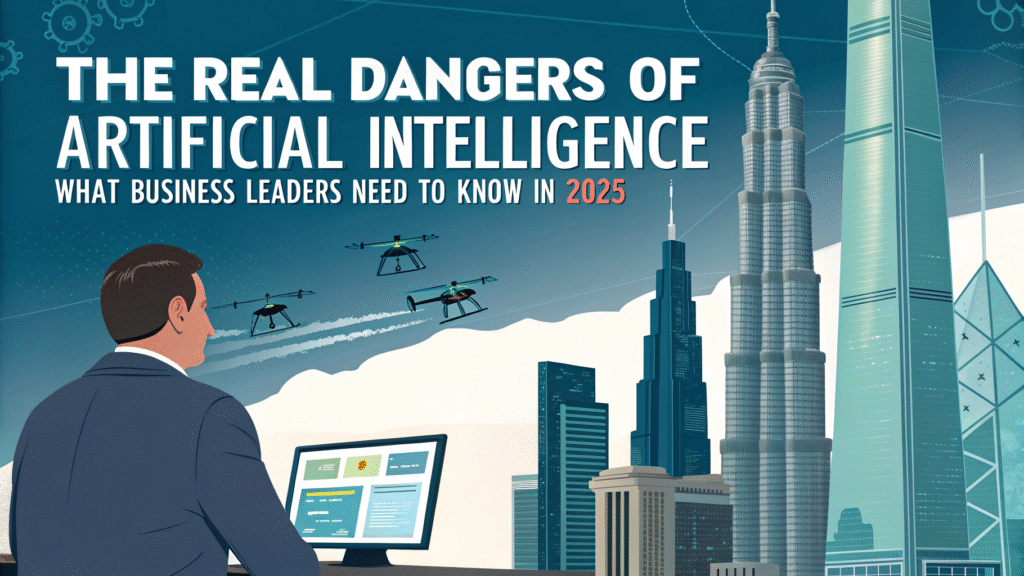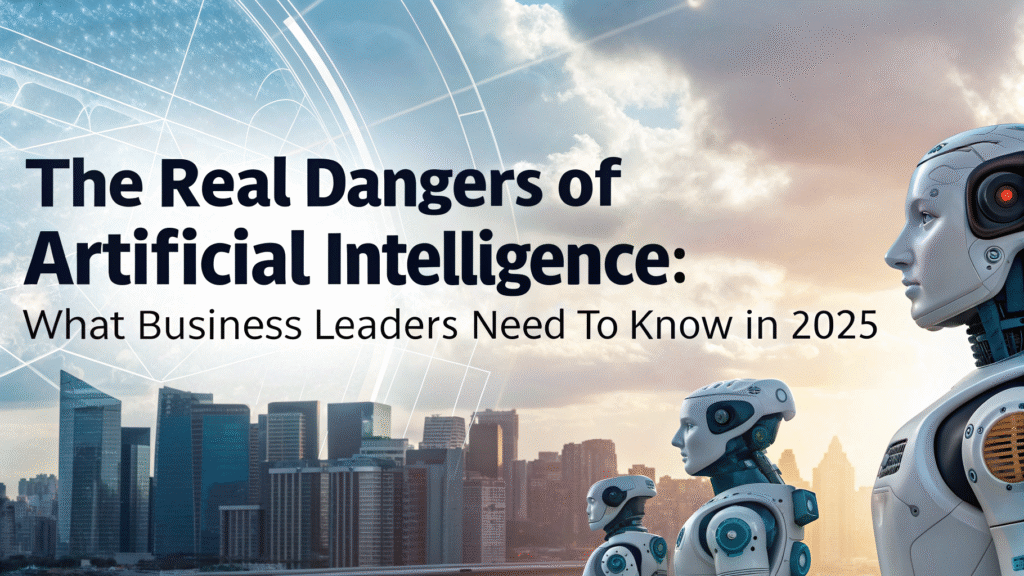
Table of Contents
- Introduction
- History & Evolution
- Audience & Demographics
- Key Features & Functions
- Business & Marketing Potential
- Best Practices & Tips
- Challenges & Limitations
- Future Outlook
- Conclusion
Introduction
Artificial intelligence has transformed from science fiction into everyday reality. While AI promises incredible benefits, understanding the dangers of artificial intelligence is crucial for anyone building a business in today’s digital landscape.
The conversation around AI risks isn’t about fear-mongering. It’s about making informed decisions. From data privacy concerns to job displacement, the challenges are real and growing. This guide breaks down what entrepreneurs, marketers, and content creators need to know about navigating AI’s darker side while still leveraging its power.
Whether you’re implementing AI tools in your workflow or simply curious about the technology shaping our future, understanding these risks helps you make smarter choices for your business and career.
History & Evolution
The story of AI dangers didn’t start yesterday. It evolved alongside the technology itself.
Early Concerns (1950s-1990s)
When researchers first developed AI concepts, concerns were mostly theoretical. Scientists like Isaac Asimov wrote about robot ethics, introducing ideas that seemed distant and abstract.
The Digital Age (2000s-2010s)
As machine learning improved, real-world issues emerged. Algorithms began making decisions about credit scores, hiring, and criminal sentencing. Bias crept into systems, often reflecting and amplifying human prejudices.
The Modern Era (2020-Present)
The release of powerful tools like GPT-3, DALL-E, and ChatGPT brought AI dangers into sharp focus. Deepfakes became convincing. Misinformation spread faster. Job security concerns intensified. The abstract became concrete.
Today, we’re not debating whether AI poses risks. We’re figuring out how to manage them while moving forward.
Audience & Demographics
Understanding who’s most affected by AI dangers helps target solutions effectively.
Primary Groups at Risk:
- Content creators facing AI-generated competition and copyright issues
- Marketing professionals navigating ethics and automation
- Small business owners making technology investment decisions
- Employees in industries vulnerable to automation
- Consumers whose data fuels AI systems
Research shows that younger professionals (ages 25–40) are both the most enthusiastic about AI and the most anxious about its impact on their careers. As a result, this demographic needs practical guidance to balance opportunity with caution.
Key Features & Functions
To understand the dangers, you need to know what AI actually does.
Core AI Capabilities
Automation: AI handles repetitive tasks faster than humans, from data entry to content generation.
Pattern Recognition: Systems identify trends in massive datasets that humans would miss.
Prediction: Algorithms forecast outcomes based on historical data, influencing everything from marketing campaigns to loan approvals.
Natural Language Processing: AI understands and generates human-like text, powering chatbots and content tools.
Where Dangers Emerge
These capabilities become problematic when systems operate with biased data, lack transparency, or make decisions without human oversight. A hiring algorithm that screens out qualified candidates based on flawed assumptions. A content generator that produces convincing misinformation. A recommendation system that creates echo chambers.
The function isn’t inherently dangerous. The implementation often is.
Business & Marketing Potential
Here’s the paradox: AI presents massive opportunities while simultaneously posing significant risks.
Legitimate Business Applications:
Companies use AI to personalize customer experiences, optimize ad spending, analyze market trends, and automate customer service. These applications drive revenue and improve efficiency.
The Risk Side:
However, over-reliance on AI can damage brand reputation. Automated customer service frustrates users. AI-generated content lacks authenticity. Predictive algorithms miss cultural nuance.
Smart businesses find the balance. They use AI as a tool, not a replacement for human judgment. In addition, the company maintains transparency about AI use. Furthermore, it invests in human oversight to catch mistakes before they reach customers.
The potential is enormous, but treating AI as a magic solution rather than a tool creates vulnerability.
Best Practices & Tips
Navigating AI dangers requires intentional strategy.
For Business Leaders:
Maintain human oversight for all AI-generated decisions. Regularly audit AI systems for bias and accuracy. Be transparent with customers about AI use. Invest in employee training rather than just replacement. Diversify your technology stack to avoid dependency on single AI platforms.
For Content Creators:
Use AI as an assistant, not a writer. Always fact-check AI-generated content. Maintain your unique voice and perspective. Disclose AI use when appropriate. Protect your original work with proper documentation.
For Marketers:
Prioritize data privacy in all AI implementations. Test AI campaigns with small audiences first. Balance automation with personalization. Monitor for algorithmic bias in targeting. Keep human creativity at the campaign’s core.
Universal Principles:
Start small. Test thoroughly. Stay informed about AI developments. Build ethical guidelines before problems emerge. Remember that AI amplifies existing problems rather than creating entirely new ones.
Challenges & Limitations
Even well-implemented AI faces significant constraints.
Technical Limitations: AI systems only work as well as their training data. They struggle with context, nuance, and truly novel situations. They can’t replicate human creativity or ethical reasoning.
Bias Problems: If training data reflects historical discrimination, AI perpetuates it. This affects hiring tools, lending algorithms, and content recommendations.
Security Vulnerabilities: AI systems can be manipulated through adversarial attacks. Data breaches expose sensitive information. Deepfakes enable sophisticated fraud.
Economic Disruption: Automation displaces workers faster than new jobs emerge. The benefits concentrate among tech companies while costs distribute widely.
Accountability Gaps: When AI makes a mistake, determining responsibility is complicated. Is it the developer, the company deploying it, or the user?
These aren’t temporary bugs to be fixed. They’re fundamental challenges requiring ongoing attention and regulation.
Future Outlook
The dangers of artificial intelligence will evolve as the technology advances.
Near-Term Expectations (2025-2028):
Expect increased regulation around AI use. The EU’s AI Act sets precedent for governance. More sophisticated deepfakes will challenge trust in media. Job displacement will accelerate in creative and analytical fields. AI literacy will become essential for career survival.
Long-Term Possibilities (2030+):
Advanced AI systems may develop capabilities their creators don’t fully understand. The gap between AI haves and have-nots could widen inequality. Autonomous systems may make decisions with global consequences. New jobs will emerge, but transition periods will be painful.
Reasons for Optimism:
Growing awareness drives better practices. Companies building ethical AI gain competitive advantages. Regulations are developing faster than many predicted. Human creativity and judgment remain valuable.
The future isn’t predetermined. Our choices today shape how these risks manifest tomorrow.

Conclusion
The dangers of artificial intelligence are real; however, they are manageable with awareness and action. Therefore, for entrepreneurs, marketers, and content creators, success requires embracing AI’s potential while still maintaining healthy skepticism about its limitations.
Treat AI as a powerful tool that requires constant supervision, rather than as an autonomous solution. At the same time, prioritize ethics alongside efficiency. Moreover, invest in understanding these systems instead of blindly adopting them.
The businesses that thrive won’t be those that avoid AI entirely, nor those that surrender completely to automation. Instead, success will favor companies that thoughtfully integrate AI while still preserving human judgment, creativity, and values.
Stay informed. Stay critical. And remember that technology serves us best when we remain its thoughtful masters, not its passive subjects.